Numerical Approach to the Plasmonic Enhancement of Cs2AgBiBr6 Perovskite-Based Solar Cell by Embedding Metallic Nanosphere
Abstract
:1. Introduction
2. Mathematical Algorithm
2.1. Fermi Golden Rule
2.2. Finite Difference Time Domain Algorithm
2.2.1. Two Differential Finite Difference Time Domain
2.2.2. Numerical Plane Wave in Finite Difference Time
2.2.3. Periodic Boundary Condition
2.3. Device Simulation Algorithm
3. Result and Discussion
3.1. Electrical Characteristics Analysis of MNSs Embedded Device
3.2. Optical Characteristics Analysis of MNSs Embedded Device
3.3. Spatial Distribution Analysis
4. Conclusions
Author Contributions
Funding
Data Availability Statement
Conflicts of Interest
References
- She, Y.; Hou, Z.; Prezhdo, O.V.; Li, W. Identifying and Passivating Killer Defects in Pb-Free Double Cs2AgBiBr6 Perovskite. J. Phys. Chem. Lett. 2021, 43, 10581–10588. [Google Scholar] [CrossRef] [PubMed]
- Zhu, M.; Li, C.; Li, B.; Zhang, J.; Sun, Y.; Guo, W.; Zhou, Z.; Pang, S.; Yan, Y. Interaction engineering in organic–inorganic hybrid perovskite solar cells. Mater. Horiz. 2020, 7, 2208–2236. [Google Scholar] [CrossRef]
- Tokmoldin, N.; Hosseini, S.M.; Raoufi, M.; Phuong, L.Q.; Sandberg, O.J.; Guan, H.; Zou, Y.; Neher, D.; Shoaee, S. Extraordinarily long diffusion length in PM6:Y6 organic solar cells. J. Mater. Chem. A. 2020, 8, 7854–7860. [Google Scholar] [CrossRef]
- Xue, J.; Wang, R.; Chen, X.; Yao, C.; Jin, X.; Wang, K.-L.; Huang, W.; Huang, T.; Zhao, Y.; Zhai, Y.; et al. Reconfiguring the band-edge states of photovoltaic perovskites by conjugated organic cations. Science 2021, 371, 636–640. [Google Scholar] [CrossRef] [PubMed]
- Zhu, C.; Niu, X.; Fu, Y.; Li, N.; Hu, C.; Chen, Y.; He, X.; Na, G.; Liu, P.; Zai, H.; et al. Strain engineering in perovskite solar cells and its impacts on carrier dynamics. Nat. Commun. 2019, 10, 815. [Google Scholar] [CrossRef] [Green Version]
- Ghasemi, M.; Zhang, L.; Yun, J.-H.; Hao, M.; He, D.; Chen, P.; Bai, Y.; Lin, T.; Xiao, M.; Du, A.; et al. Dual-Ion-Diffusion Induced Degradation in Lead-Free Cs2AgBiBr6 Double Perovskite Solar Cells. Adv. Funct. Mater. 2020, 30, 2002342. [Google Scholar] [CrossRef]
- Ou, Y.; Lu, Z.; Lu, Y.; Zhong, X.; Chen, P.; Zhou, L.; Chen, T. Boosting the stability and efficiency of Cs2AgBiBr6 perovskite solar cells via Zn doping. Opt. Mater. 2022, 129, 112452. [Google Scholar] [CrossRef]
- Yang, X.; Wang, W.; Ran, R.; Zhou, W.; Shao, Z. Recent Advances in Cs2AgBiBr6-Based Halide Double Perovskites as Lead-Free and Inorganic Light Absorbers for Perovskite Solar Cells. Energ. Fuel 2020, 34, 10513–10528. [Google Scholar] [CrossRef]
- Ghosh, J.; Sellin, P.J.; Giri, P.K. Recent advances in lead-free double perovskites for x-ray and photodetection. Nanotechnology 2022, 33, 312001. [Google Scholar] [CrossRef]
- Pang, B.; Chen, X.; Bao, F.; Liu, Y.; Feng, T.; Dong, H.; Yu, L.; Dong, L. Improved charge extraction and atmospheric stability of all-inorganic Cs2AgBiBr6 perovskite solar cells by MoS2 nanoflakes. Sol. Energy Mater. Sol. Cells 2022, 246, 111932. [Google Scholar] [CrossRef]
- Fan, P.; Peng, H.-X.; Zheng, Z.-H.; Chen, Z.-H.; Tan, S.-J.; Chen, X.-Y.; Luo, Y.-D.; Su, Z.-H.; Luo, J.-T.; Liang, G.-X. Single-Source Vapor-Deposited Cs2AgBiBr6 Thin Films for Lead-Free Perovskite Solar Cells. Nanomaterials 2019, 9, 1760. [Google Scholar] [CrossRef] [Green Version]
- Dasri, T. Theoretical calculation of plasmonic enhancement of silver nanosphere, nanocube, and nanorod embedded in organic solar cells. Integr. Ferroelectr. 2016, 175, 176–185. [Google Scholar] [CrossRef]
- N’Konou, K.; Peres, L.; Torchio, P. Optical Absorption Modeling of Plasmonic Organic Solar Cells Embedding Silica-Coated Silver Nanospheres. Plasmonics 2018, 13, 297–303. [Google Scholar] [CrossRef]
- Erwin, W.R.; Zarick, H.F.; Talbert, E.M.; Bardhan, R. Light trapping in mesoporous solar cells with plasmonic nanostructures. Energy Environ. Sci. 2016, 9, 1577–1601. [Google Scholar] [CrossRef] [Green Version]
- Zhang, W.; Saliba, M.; Stranks, S.D.; Sun, Y.; Shi, X.; Wiesner, U.; Snaith, H.J. Enhancement of Perovskite-Based Solar Cells Employing Core–Shell Metal Nanoparticles. Nano Lett. 2013, 13, 4505–4510. [Google Scholar] [CrossRef] [PubMed] [Green Version]
- Yao, K.; Zhong, H.; Liu, Z.; Xiong, M.; Leng, S.; Zhang, J.; Xu, Y.-X.; Wang, W.; Zhou, L.; Huang, H.; et al. Plasmonic Metal Nanoparticles with Core-Bishell Structure for High-Performance Organic and Perovskite Solar Cells. ACS Nano 2019, 13, 5397–5409. [Google Scholar] [CrossRef]
- Wu, R.; Yang, B.; Zhang, C.; Huang, Y.; Cui, Y.; Liu, P.; Zhou, C.; Hao, Y.; Gao, Y.; Yang, J. Prominent Efficiency Enhancement in Perovskite Solar Cells Employing Silica-Coated Gold Nanorods. J. Phys. Chem. C. 2016, 120, 6996–7004. [Google Scholar] [CrossRef]
- Chen, H.; Kou, X.; Yang, Z.; Ni, W.; Wang, J. Shape-and Size-Dependent Refractive Index Sensitivity of Gold Nanoparticles. Langmuir 2008, 24, 5233–5237. [Google Scholar] [CrossRef]
- Lin, G.-J.; Wang, H.-P.; Lien, D.-H.; Fu, P.-H.; Chang, H.-C.; Ho, C.-H.; Lin, C.-A.; Lai, K.-Y.; He, J.-H. A broadband and omnidirectional light-harvesting scheme employing nanospheres on Si solar cells. Nano Energy 2014, 6, 36–43. [Google Scholar] [CrossRef]
- Jeong, M.; Choi, I.W.; Yim, K.; Jeong, S.; Kim, M.; Choi, S.J.; Cho, Y.; An, J.-H.; Kim, H.-B.; Jo, Y.; et al. Large-area perovskite solar cells employing spiro-Naph hole transport material. Nat. Photonics 2022, 16, 119–125. [Google Scholar] [CrossRef]
- Islam, M.T.; Jani, M.R.; Al Amin, S.M.; Sami, M.S.U.; Shorowordi, K.M.; Hossain, M.I.; Devgun, M.; Chowdhury, S.; Banerje, S.; Ahmed, S. Numerical simulation studies of a fully inorganic Cs2AgBiBr6 perovskite solar device. Opt. Mater. 2020, 105, 109957. [Google Scholar] [CrossRef]
- Bag, A.; Radhakrishnan, R.; Nekovei, R.; Jeyakumar, R. Effect of absorber layer, hole transport layer thicknesses, and its doping density on the performance of perovskite solar cells by device simulation. Sol. Energy 2020, 196, 177–182. [Google Scholar] [CrossRef]
- Tang, B.; Guo, Z.; Jin, G. Polarization-controlled and symmetry-dependent multiple plasmon-induced transparency in graphene-based metasurfaces. Opt. Express 2022, 30, 35554–35566. [Google Scholar] [CrossRef]
- Wu, F.; Shi, P.; Yi, Z.; Li, H.; Yi, Y. Ultra-Broadband Solar Absorber and High-Efficiency Thermal Emitter from UV to Mid-Infrared Spectrum. Micromachines 2023, 14, 985. [Google Scholar] [CrossRef] [PubMed]
- Lai, R.; Shi, P.; Yi, Z.; Li, H.; Yi, Y. Triple-Band Surface Plasmon Resonance Metamaterial Absorber Based on Open-Ended Prohibited Sign Type Monolayer Graphene. Micromachines 2023, 14, 953. [Google Scholar] [CrossRef] [PubMed]
- Tang, B.; Li, Z.; Palacios, E.; Liu, Z.; Butun, S.; Aydin, K. Chiral-Selective Plasmonic Metasurface Absorbers Operating at Visible Frequencies. IEEE Photon. Technol. Lett. 2017, 29, 295–298. [Google Scholar] [CrossRef]
- Seo, K.-H.; Biswas, S.; Jeon, S.-H.; Hyeok, K.; Bae, J.-H. Optical modeling and active layer design of MASnI3 perovskite photovoltaics using finite-difference time-domain simulation: From the sun to indoor light. Jpn. J. Appl. Phys. 2023, 62, SE1003. [Google Scholar] [CrossRef]
- Suwaga, K.; Tahara, H.; Yamashita, A.; Otsuki, J.; Sagara, T.; Harumoto, T.; Yanagida, S. Refractive Index Susceptibility of the Plasmonic Palladium Nanoparticles: Potential as the Third Plasmonic Sensing Material. ACS Nano 2015, 9, 1895–1904. [Google Scholar] [CrossRef]
- Laska, M.; Krzemińska, Z.; Kluczyk-Korch, K.; Schaadt, D.; Popko, E.; Jacak, W.A.; Jacak, J.E. Metallization of solar cells, exciton channel of plasmon photovoltaic effect in perovskite cells. Nano Energy 2020, 75, 104751. [Google Scholar] [CrossRef]
- Kluczyk, K.; David, C.; Jacak, J.; Jacak, W. On Modeling of Plasmonic-Induced Enhancement of the Efficiency of Solar Cells Modified by Metallic Nano-Particles. Nanomaterials 2019, 9, 3. [Google Scholar] [CrossRef] [Green Version]
- Sullivan, D.M. Two-Dimensional Simulation; IEEE: New York, NY, USA, 2013; pp. 53–84. [Google Scholar]
- Tan, T.; Potter, M. On the Nature of Numerical Plane Waves in FDTD. IEEE Antennas Wirel. Propag. Lett. 2009, 8, 505–508. [Google Scholar]
- Kogon, A.J.; Sarris, C.D. Finite-Difference Time-Domain Modeling of Periodic Structures: A review of constant wave vector techniques. IEEE Antennas Propag. M. 2022, 63, 59–70. [Google Scholar] [CrossRef]
- Johnson, P.B.; Christy, R.W. Optical Constants of the Noble Metals. Phys. Rev. B 1972, 6, 4370–4379. [Google Scholar] [CrossRef]
- Johnson, P.B.; Christy, R.W. Optical constants of transition metals: Ti, V, Cr, Mn, Fe, Co, Ni, and Pd. Phys. Rev. B 1974, 9, 5056–5070. [Google Scholar] [CrossRef]
- Vincent, P.; Bae, J.-H.; Kim, H. Efficiently-designed hybrid tandem photovoltaic with organic and inorganic single cells. J. Korean Phys. Soc. 2016, 68, 1094–1098. [Google Scholar] [CrossRef]
- Samajdar, D.P. Light-trapping strategy for PEDOT:PSS/c-Si nanopyramid based hybrid solar cells embedded with metallic nanoparticles. Sol. Energy 2019, 190, 278–285. [Google Scholar]
- Jacak, J.E.; Jacak, W.A. Routes for Metallization of Perovskite Solar Cells. Materials 2022, 15, 2254. [Google Scholar] [CrossRef]
- Mulyanti, B.; Wulandari, C.; Hasanah, L.; Pawinanto, R.E.; Hamidah, I. Absorption Performance of Doped TiO2-Based Perovskite Solar Cell using FDTD Simulation. Model. Simul. Eng. 2022, 2022, 9299279. [Google Scholar] [CrossRef]
- Yu, W.; Zou, Y.; Wang, H.; Qu, B.; Chen, Z.; Chao, L. Expanding the Absorption of Double Perovskite Cs2AgBiBr6 to NIR Region. J. Phys. Chem. Lett. 2023, 14, 5310–5317. [Google Scholar] [CrossRef]
- Liu, G.; Zhang, Z.; Wu, C.; Zhang, Y.; Li, X.; Yu, W.; Yao, G.; Liu, S.; Shi, J.-J.; Liu, K.; et al. Extending Absorption of Cs2AgBiBr6 to Near-Infrared Region (≈1350 nm) with Intermediate Band. Adv. Funct. Mater. 2021, 32, 2109891. [Google Scholar] [CrossRef]
- Alshammari, A.S.; Bagabas, A.; Alarifi, N.; Altamimi, R. Effect of the Nature of Metal Nanoparticles on the Photocatalytic Degradation of Rhodamine B. Top. Catal. 2019, 62, 4797. [Google Scholar] [CrossRef]
- Hasanah, L.; Ashidiq, A.; Pawinanto, R.E.; Mulyanti, B.; Wulandari, C.; Zain, M.; Rifqi, A. Dimensional Optimization of TiO2 Nanodisk Photonic Crystals on Lead Iodide (MAPbI3) Perovskite Solar Cells by Using FDTD Simulations. Appl. Sci. 2021, 12, 351. [Google Scholar] [CrossRef]
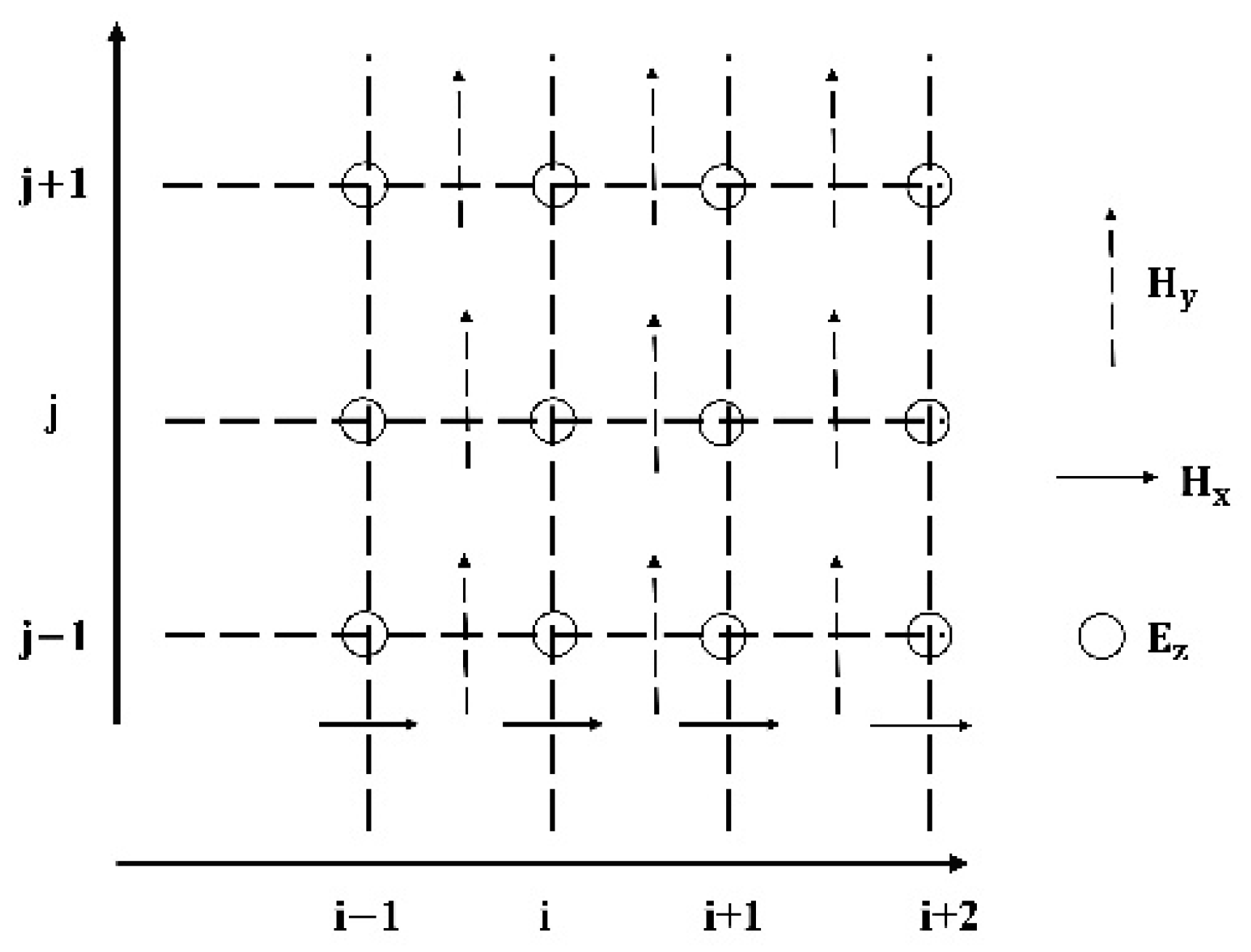
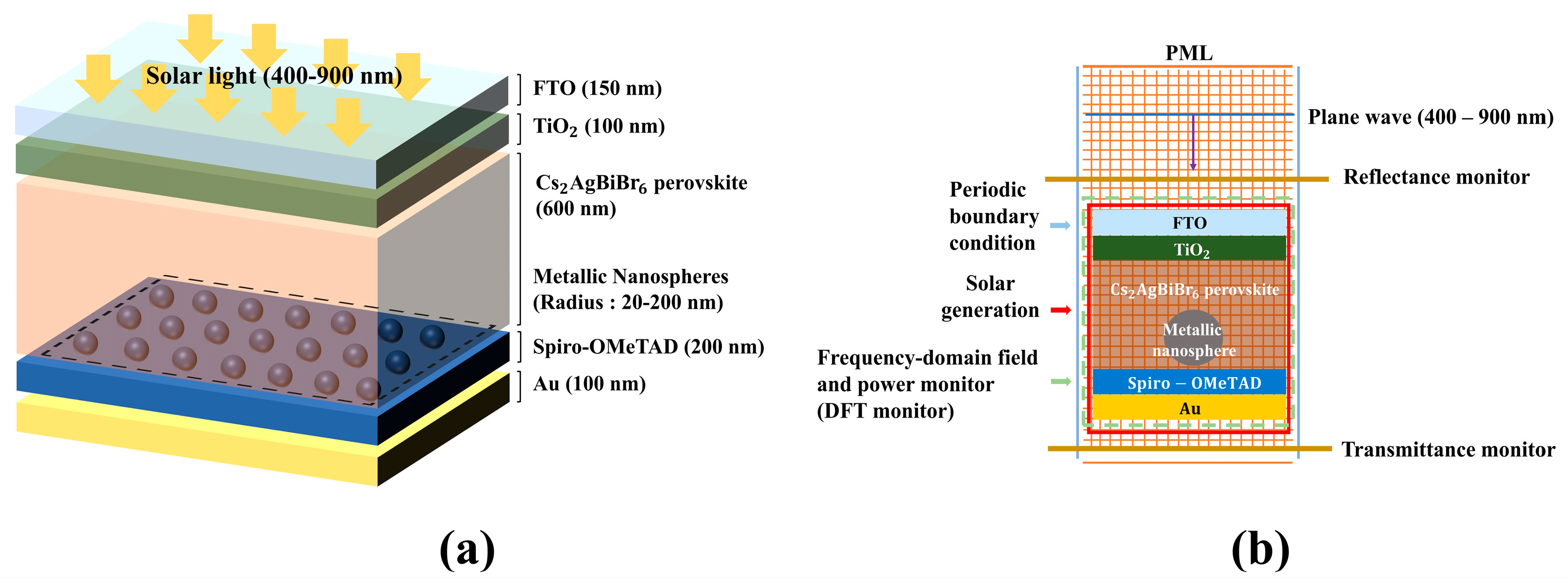

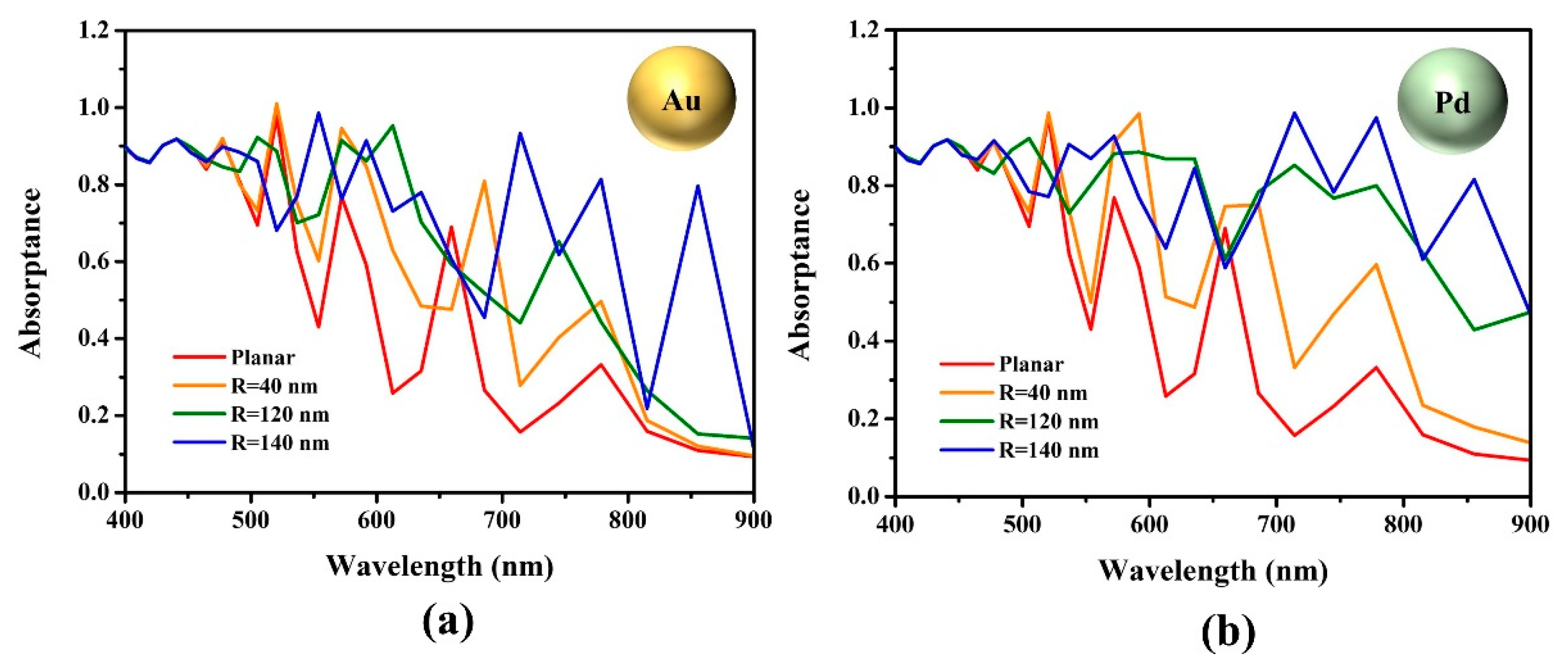
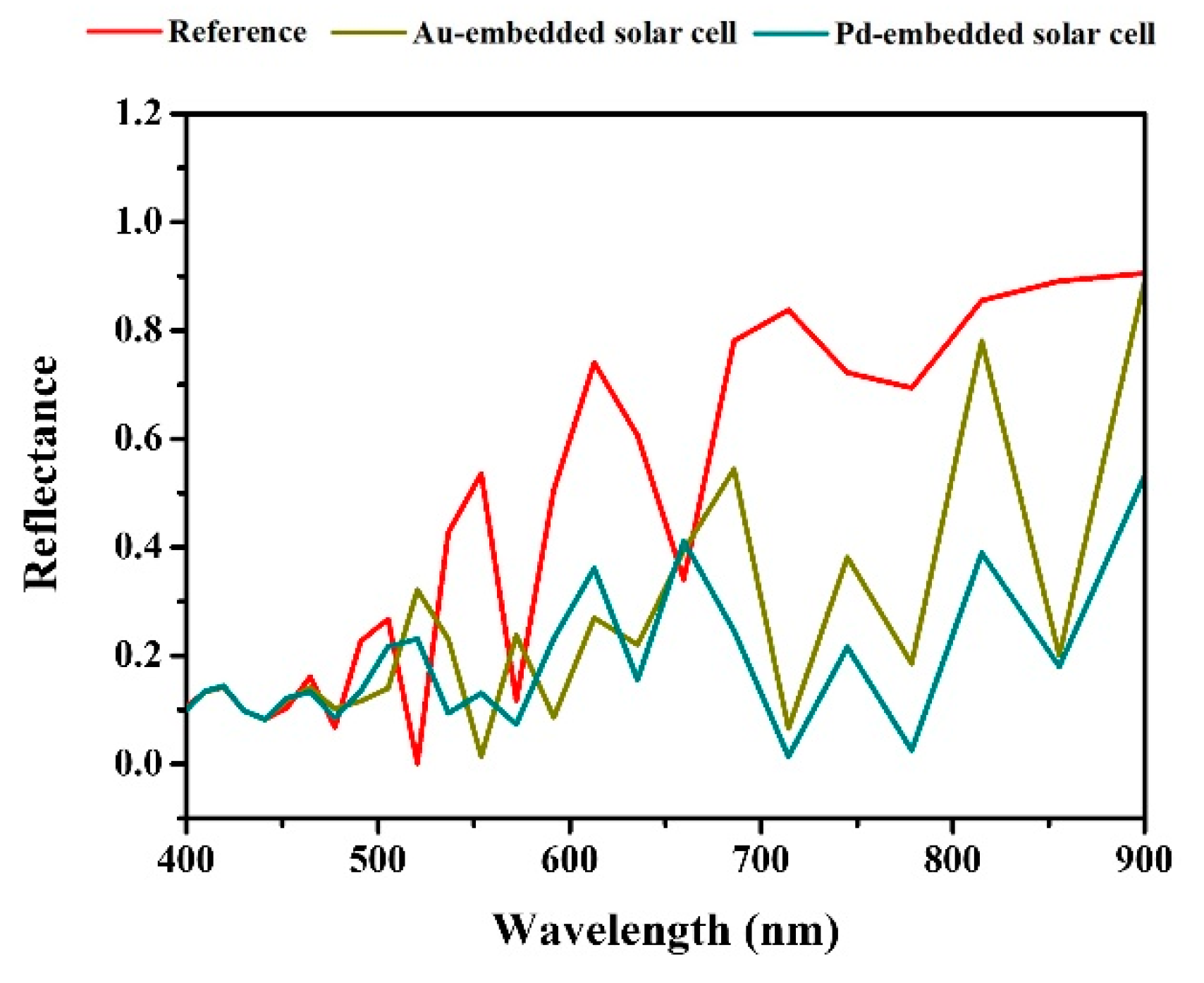

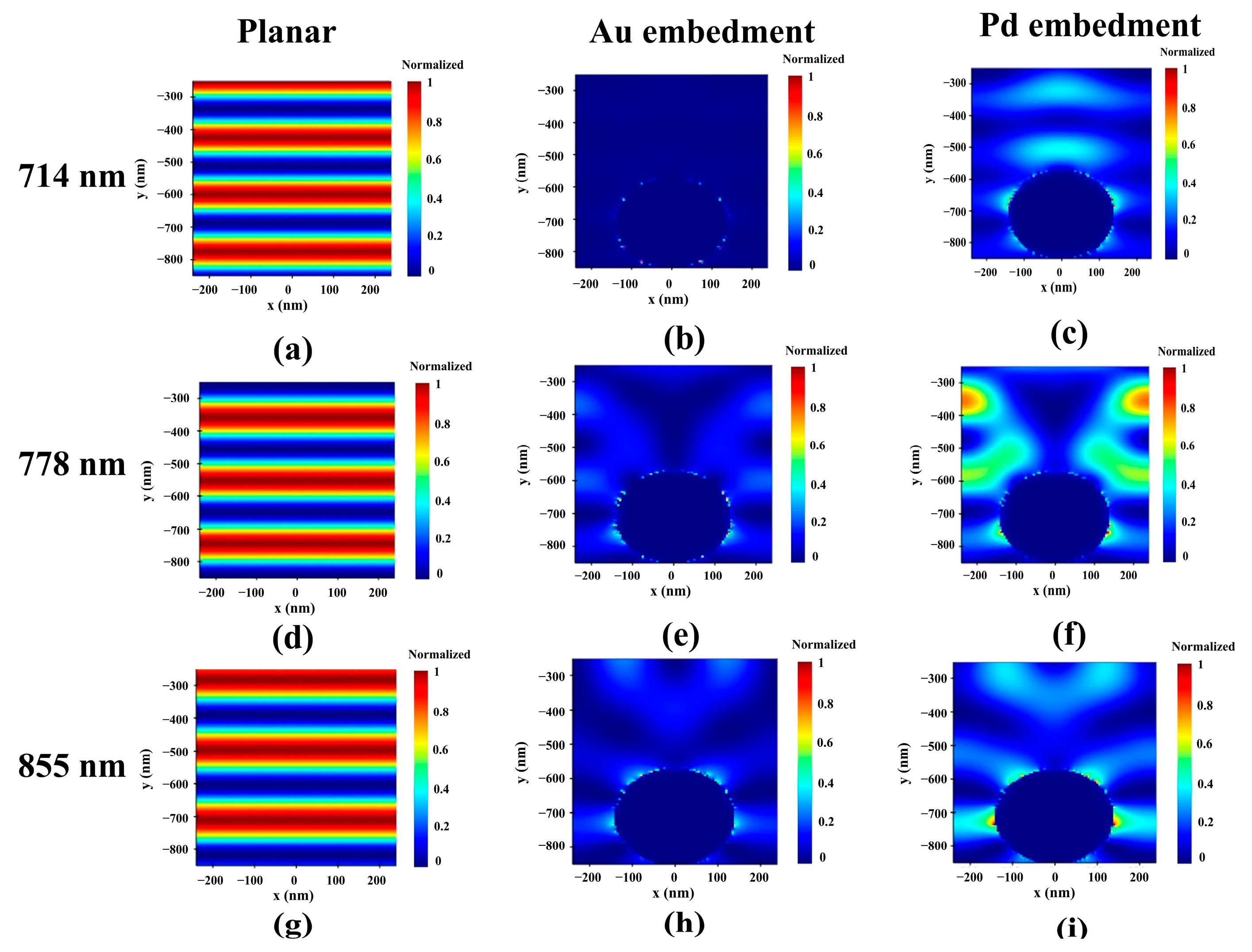
| Radius (nm) | Jsc,max (mA/cm2) | |
|---|---|---|
| Au | Pd | |
| 0 | 14.23 | 14.23 |
| 20 | 16.33 | 15.55 |
| 40 | 17.9 | 18.95 |
| 60 | 20.5 | 23.03 |
| 80 | 20.85 | 24.47 |
| 100 | 20.73 | 24.52 |
| 120 | 19.63 | 24.54 |
| 140 | 22.84 | 25.81 |
| 160 | 20.26 | 25.9 |
| 180 | 19.87 | 24.94 |
| 200 | 19.27 | 25.66 |
| MNS Embedment | Absorptance Enhancement (%) |
|---|---|
| Without MNS (ref) | - |
| Au MNS | 14 |
| Au 120 nm | 22 |
| Au 140 nm | 30 |
| Pd 40 nm | 17 |
| Pd 120 nm | 37 |
| Pd 140 nm | 40 |
| MNS Embedment | Reflectance Loss (%) |
|---|---|
| Without MNS (ref) | - |
| Au MNS | 42 |
| Pd MNS | 57 |
Disclaimer/Publisher’s Note: The statements, opinions and data contained in all publications are solely those of the individual author(s) and contributor(s) and not of MDPI and/or the editor(s). MDPI and/or the editor(s) disclaim responsibility for any injury to people or property resulting from any ideas, methods, instructions or products referred to in the content. |
© 2023 by the authors. Licensee MDPI, Basel, Switzerland. This article is an open access article distributed under the terms and conditions of the Creative Commons Attribution (CC BY) license (https://creativecommons.org/licenses/by/4.0/).
Share and Cite
Seo, K.-H.; Zhang, X.; Park, J.; Bae, J.-H. Numerical Approach to the Plasmonic Enhancement of Cs2AgBiBr6 Perovskite-Based Solar Cell by Embedding Metallic Nanosphere. Nanomaterials 2023, 13, 1918. https://doi.org/10.3390/nano13131918
Seo K-H, Zhang X, Park J, Bae J-H. Numerical Approach to the Plasmonic Enhancement of Cs2AgBiBr6 Perovskite-Based Solar Cell by Embedding Metallic Nanosphere. Nanomaterials. 2023; 13(13):1918. https://doi.org/10.3390/nano13131918
Chicago/Turabian StyleSeo, Kyeong-Ho, Xue Zhang, Jaehoon Park, and Jin-Hyuk Bae. 2023. "Numerical Approach to the Plasmonic Enhancement of Cs2AgBiBr6 Perovskite-Based Solar Cell by Embedding Metallic Nanosphere" Nanomaterials 13, no. 13: 1918. https://doi.org/10.3390/nano13131918
APA StyleSeo, K.-H., Zhang, X., Park, J., & Bae, J.-H. (2023). Numerical Approach to the Plasmonic Enhancement of Cs2AgBiBr6 Perovskite-Based Solar Cell by Embedding Metallic Nanosphere. Nanomaterials, 13(13), 1918. https://doi.org/10.3390/nano13131918







